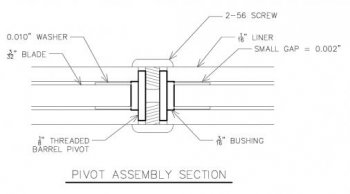C Craft
Well-Known Member
I am looking for a little advice on the thickness of material for folders, as well as a few other questions concerning folders. I realize there is a folder forum but as I am new to this as I have made only one friction folder to date.
I am planning on making these first folder attempts from 1084. I know that may not be the steel of choice for most folks making folders but these will be my first folders. I prefer to work in a steel that I know and have the ability to HT~
Aldo has 1084 in .125-1/8, .156-5/32, .187-3/16, and
.250-1/4.
I want to build a couple of friction folders, so for them I am thinking, .156-5/32.
I also want to try my hand at a couple of EDC, lockback folders and I am thinking, .125-1/8 for those.
Anyone got any suggestions and why you would/wouldn't use a particular thickness, for folders??
Also what do you recommend as the best steel for spring material?? Will the 1084 work for spring and the pivoting lockback/rocker bar???
I am planning on making these first folder attempts from 1084. I know that may not be the steel of choice for most folks making folders but these will be my first folders. I prefer to work in a steel that I know and have the ability to HT~
Aldo has 1084 in .125-1/8, .156-5/32, .187-3/16, and
.250-1/4.
I want to build a couple of friction folders, so for them I am thinking, .156-5/32.
I also want to try my hand at a couple of EDC, lockback folders and I am thinking, .125-1/8 for those.
Anyone got any suggestions and why you would/wouldn't use a particular thickness, for folders??
Also what do you recommend as the best steel for spring material?? Will the 1084 work for spring and the pivoting lockback/rocker bar???
Last edited:


